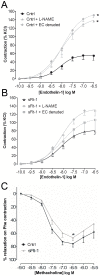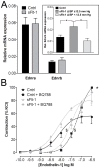SFlt-1 elevates blood pressure by augmenting endothelin-1-mediated vasoconstriction in mice
- PMID: 24632840
- PMCID: PMC3954828
- DOI: 10.1371/journal.pone.0091897
SFlt-1 elevates blood pressure by augmenting endothelin-1-mediated vasoconstriction in mice
Abstract
Objective: Scavenging of vascular endothelial growth factor (VEGF) elevates blood pressure (BP) in patients receiving anti-angiogenic therapy. Similarly, inhibition of circulation VEGF by its soluble receptor fms-like tyrosine kinase-1 (sFlt-1) underlies BP elevation in pre-eclampsia. Both phenotypes are characterized by augmented production of endothelin-1 (ET-1), suggesting a role for ET-1 in anti-angiogenic hypertension. We aimed to assess the effect of VEGF inhibition on ET-1-induced contractility and downstream ET-1 signaling.
Approach and results: Male C57BL/6N mice were treated with either sFlt-1 or vehicle and BP was assessed via tail-cuff. Mean arterial pressure of sFlt-1-treated mice markedly increased compared to vehicle-treated controls (N = 11-12, p<0.05). After sacrifice, carotid and mesenteric arteries were isolated for isometric tension measurements. ET-1-induced contractions were similar in mesenteric arteries of vehicle and sFlt-1-treated mice, but augmented in carotid segments of sFlt-1-treated mice compared to controls (N = 9-10, p<0.05). The increased contraction in carotid segments could be completely abrogated by the cyclooxygenase (COX) inhibitor indomethacin (N = 9-10, p<0.05), indicating heightened prostaglandin-mediated vasoconstriction. This was associated with a shift towards procontractile ETB signaling in sFlt-1-treated mice, possibly explaining the increased ET-1-induced prostaglandin-mediated vasoconstriction. In line with the ex vivo findings, sFlt-1-induced BP elevation could be prevented in vivo by oral treatment with either a high-dose of the COX inhibitor aspirin (N = 7) or with picotamide (N = 9), a dual thromboxane A2 synthase inhibitor and receptor antagonist.
Conclusions: VEGF inhibition augments the pressor response to ET-1. The cyclooxygenase-thromboxane signaling route downstream of ET-1 might be a possible target to prevent BP elevation during VEGF inhibition.
Conflict of interest statement
Figures





References
-
- Zhu X, Wu S, Dahut WL, Parikh CR (2007) Risks of proteinuria and hypertension with bevacizumab, an antibody against vascular endothelial growth factor: systematic review and meta-analysis. Am J Kidney Dis 49: 186–193. - PubMed
-
- Jebbink J, Keijser R, Veenboer G, van der Post J, Ris-Stalpers C, et al. (2011) Expression of placental FLT1 transcript variants relates to both gestational hypertensive disease and fetal growth. Hypertension 58: 70–76. - PubMed
-
- Levine RJ, Maynard SE, Qian C, Lim KH, England LJ, et al. (2004) Circulating angiogenic factors and the risk of preeclampsia. N Engl J Med 350: 672–683. - PubMed
Publication types
MeSH terms
Substances
LinkOut - more resources
Full Text Sources
Other Literature Sources
Miscellaneous

